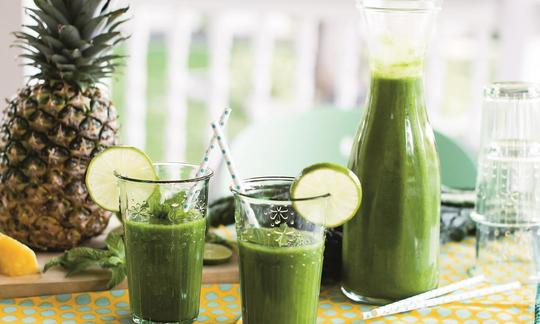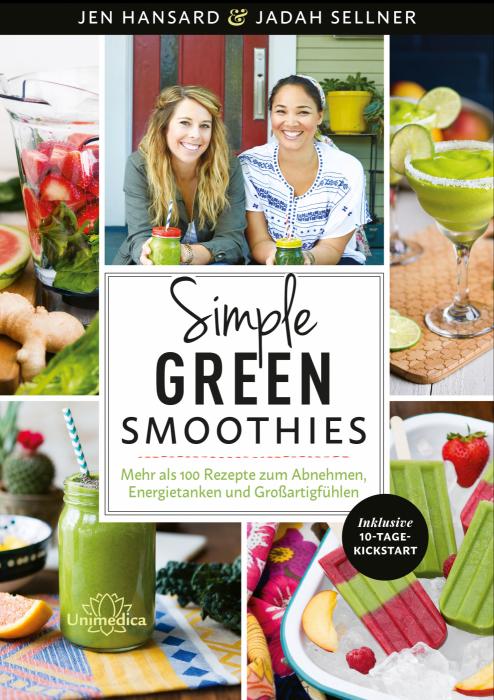Pineapple Mojito Green Smoothie
raw-vegan
Ingredients (for servings, )
| 20 oz | Pineapple, raw (organic?) |
| 3 ¼ oz | Kale, raw (spring cabbage, organic?) |
| ¼ bunch | Peppermint, fresh (raw, organic?) (0.18 oz) |
| 500 ml | Coconut water, raw? (Coconut water, coconut juice, organic?) (18 oz) |
| 1 | Limes, raw (organic?) (2.4 oz) |
Equipment
- hand-held blender / immersion blender or blender
- refrigerator
- citrus juicer (lemon squeezer)
- freezer
Type of preparation
- chop or grind
- food preparation without heating
- blend
- squeeze
- put on ice
- cool
- peel
Preparation
Preparation — optional
Remove the skin from the pineapple and cut the fruit into small chunks. Freeze the fruit until you are ready to prepare the smoothie.This step is optional, so we have not included the time required for this step in the total preparation time for the recipe. You can also prepare the fruit the day before and freeze it overnight.
For the smoothie
Wash and remove the stems from the kale and then blend with the mint and coconut water until the mixture is smooth.The original recipe lists 70 g of kale without stems for two servings. We have adjusted the quantity of the other ingredients to ensure that you will have enough kale.
If you have not prepared the pineapple in advance, remove the peel from the pineapple and cut the fruit into chunks. Squeeze the juice from the lime and add it to the smoothie along with the (frozen) pineapple chunks.
Blend all of the ingredients until smooth. Serve the pineapple mojito in an attractive glass.
You can also chill the smoothie before serving if you didn’t use frozen fruit. However, it tastes best when served immediately.
|
Nutritional Information per person
Convert per 100g
|
2000 kcal | |
|---|---|---|
| Energy | 225 kcal | 11.2% |
| Fat/Lipids | 1.4 g | 1.9% |
| Saturated Fats | 0.53 g | 2.6% |
| Carbohydrates (inc.dietary fiber) | 55 g | 20.2% |
| Sugars | 36 g | 40.3% |
| Fiber | 9.5 g | 38.2% |
| Protein/Albumin | 5.6 g | 11.2% |
| Cooking Salt (Na:287.8 mg) | 731 mg | 30.5% |
| Essential micronutrients with the highest proportions | per person | 2000 kcal | |
|---|---|---|---|
| Vit | Vitamin K | 319 µg | 426.0% |
| Vit | Vitamin C (ascorbic acid) | 207 mg | 259.0% |
| Min | Manganese, Mn | 3.3 mg | 167.0% |
| Min | Copper, Cu | 1.1 mg | 112.0% |
| Vit | Vitamin B9, B11 (Folate, as the active form of folic acid) | 128 µg | 64.0% |
| Elem | Potassium, K | 1'214 mg | 61.0% |
| Vit | Vitamin B6 (pyridoxine) | 0.54 mg | 39.0% |
| Sodium, Na | 288 mg | 36.0% | |
| Elem | Magnesium, Mg | 123 mg | 33.0% |
| Vit | Vitamin B1 (Thiamine) | 0.36 mg | 33.0% |
Detailed Nutritional Information per Person for this Recipe
The majority of the nutritional information comes from the USDA (US Department of Agriculture). This means that the information for natural products is often incomplete or only given within broader categories, whereas in most cases products made from these have more complete information displayed.
If we take flaxseed, for example, the important essential amino acid ALA (omega-3) is only included in an overarching category whereas for flaxseed oil ALA is listed specifically. In time, we will be able to change this, but it will require a lot of work. An “i” appears behind ingredients that have been adjusted and an explanation appears when you hover over this symbol.
For Erb Muesli, the original calculations resulted in 48 % of the daily requirement of ALA — but with the correction, we see that the muesli actually covers >100 % of the necessary recommendation for the omega-3 fatty acid ALA. Our goal is to eventually be able to compare the nutritional value of our recipes with those that are used in conventional western lifestyles.
| Essential fatty acids | per person | 2000 kcal |
|---|---|---|
| Alpha-Linolenic acid; ALA; 18:3 omega-3 | 0.15 g | 7.0% |
| Linoleic acid; LA; 18:2 omega-6 | 0.15 g | 1.0% |
| Essential amino acids | per person | 2000 kcal |
|---|---|---|
| Tryptophan (Trp, W) | 0.04 g | 15.0% |
| Threonine (Thr, T, irreversibly transaminated) | 0.12 g | 13.0% |
| Valin (Val, V) | 0.18 g | 11.0% |
| Isoleucine (Ile, I) | 0.13 g | 10.0% |
| Phenylalanine (Phe, F) | 0.16 g | 10.0% |
| Leucine (Leu, L) | 0.21 g | 9.0% |
| Lysine (Lys, K, irreversibly transaminated) | 0.16 g | 9.0% |
| Methionine (Met, M) | 0.07 g | 7.0% |
| Vitamins | per person | 2000 kcal |
|---|---|---|
| Vitamin K | 319 µg | 426.0% |
| Vitamin C (ascorbic acid) | 207 mg | 259.0% |
| Vitamin B9, B11 (Folate, as the active form of folic acid) | 128 µg | 64.0% |
| Vitamin B6 (pyridoxine) | 0.54 mg | 39.0% |
| Vitamin B1 (Thiamine) | 0.36 mg | 33.0% |
| Vitamin A, as RAE | 240 µg | 30.0% |
| Vitamin B2 (Riboflavin) | 0.31 mg | 22.0% |
| Vitamin B3 (Niacin) | 2.2 mg | 14.0% |
| Vitamin B5 (Pantothenic acid) | 0.84 mg | 14.0% |
| Vitamin E, as a-TEs | 0.82 mg | 7.0% |
| Essential macroelements (macronutrients) | per person | 2000 kcal |
|---|---|---|
| Potassium, K | 1'214 mg | 61.0% |
| Sodium, Na | 288 mg | 36.0% |
| Magnesium, Mg | 123 mg | 33.0% |
| Calcium, Ca | 183 mg | 23.0% |
| Phosphorus, P | 123 mg | 18.0% |
| Essential trace elements (micronutrients) | per person | 2000 kcal |
|---|---|---|
| Manganese, Mn | 3.3 mg | 167.0% |
| Copper, Cu | 1.1 mg | 112.0% |
| Iron, Fe | 2.6 mg | 18.0% |
| Zinc, Zn | 0.91 mg | 9.0% |
| Selenium, Se | 3.4 µg | 6.0% |
Narayana Verlag GmbH /Unimedica Verlag , Jen Hansard, Jadah Sellner
Raw recipes 111 (3), Cooked recipes 9
Additional photos (6)
In "Simple Green Smoothies," the authors' formula for better health, more concentration, and energy is: drink a green smoothie every day.
Since this book is written in German, a description is omitted here. If you are interested, please switch to German in the menu.
This pineapple mojito uses isotonic coconut water as a base. It also contains kale, fresh mint, and tangy lime juice.
Chilled smoothie: The authors recommend using frozen pineapple for a nice cold smoothie. We did not include freezing time in the total preparation time since we consider this to be an optional step. You can also freeze the fruit overnight or chill the smoothie after you prepare it.
Pineapple and bromelain: Ripe, juicy pineapple is known for its sweet and fruity flavor that is slightly tart. It is a good source of vitamins (especially Vitamin C) and minerals as well as enzymes. One enzyme, bromelain, belongs to the cysteine protease class of enzymes. By breaking down proteins, it acts as a tenderizer for meat as well as a digestive aid. Bromelain is also to blame for the unpleasantly bitter taste experienced when dairy products are combined with pineapple. Most importantly, since bromelain is a proteolytic enzyme, medical professionals use it to treat acute or chronic inflammation and as a digestive aid. In preclinical trials and pharmacological studies, bromelain has also displayed wound healing and anticancer properties.
Kale: Kale is a fast-growing plant in the cabbage family. It can be found throughout the world and, like cauliflower, originated from wild cabbage (Brassica oleracea L.). This hearty winter vegetable contains high levels of vitamin C. Kale provides a broad variety of nutrients including many vitamins, fiber, and phytonutrients. This smoothie recipe uses raw kale, which has more nutritional value than cooked kale. Most cooking processes destroy heat-sensitive vitamins, which remain available in raw kale.
Coconut water: Not to be confused with coconut milk, coconut water is a practically fat-free, clear liquid in the fruit’s center. The amount of coconut water in the fruit decreases as the coconut ripens. It is naturally isotonic, meaning it has the same concentration of salts and minerals found in blood, and is low in calories. While these qualities make it an excellent source of hydration that is easily absorbed by the body, the low levels of glucose and sodium in this beverage make it unsuitable as an oral rehydration solution (glucose-electrolyte solution for the treatment of severe diarrhea).
Purchasing and storing kale: The leaves should be crisp and dark green. Wilted or dry leaves are usually yellowish. When kept in the refrigerator, fresh kale will retain most of its nutrients for up to five days. Kale freezes well if it is blanched first and placed in plastic bags or freezer-safe containers.
Canned pineapple: If you don’t have fresh pineapple available, you can use canned pineapple, but it can hardly be compared with the fresh product in terms of quality. Canned pineapple often undergoes heat processing and contains added citric acid or sugar to improve the shelf life.




